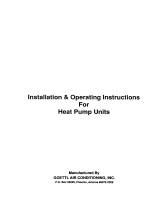
507722-02 Page 7 of 12Issue 1915
Defrost Control
The defrost control board includes the combined functions
of time/temperature defrost control, defrost relay, diagnostic
LEDs and terminal strip for eld wiring connections (see
Figure 7).
The control provides automatic switching from normal
heating operation to defrost mode and back. During the
compressor cycle (call for defrost), the control accumulates
compressor run time at 30, 60, 90 minute eld-adjustable
intervals. If the defrost thermostat is closed when the
selected compressor run time interval ends, the defrost
relay is energized and the defrost begins.
1. An on-board outdoor ambient temperature sensor on
the defrost control bypasses the low pressure switch
during low ambient temperature below 15°F in heating
mode to eliminate nuisance low pressure trips.
NOTE: 15°F is an approximate temperature,
depending upon model and installation location.
2. A defrost cycle will initiate when there has been a low
pressure switch trip; the defrost sensor must be closed
and the defrost time interval must not have expired.
3. At the end of the defrost cycle, when the unit goes
back to heating mode, the low pressure switch is
checked to see if it has reset. If so, the strikeout is not
counted. This prevents lockout during extreme winter
conditions.
Figure 7. Defrost Control Board
24V TERMINAL
STRIP
CONNECTIONS
DIAGNOSTIC
LEDS
HIGH PRESSURE
SWITCH
TEST
PINS
DEFROST TIMING
PINS (P1)
REVERSING
VALVE
DEFROST
THERMOSTAT (S6)
LOW PRESSURE
SWITCH
COMPRESSOR
DELAY PINS
S4
S87
SERVICE LIGHT
CONNECTIONS
Defrost Control Timing Pins
Each timing pin selection provides a different accumulated
compressor run time period during one thermostat run
cycle. This time period must occur before a defrost cycle
is initiated. The defrost interval can be adjusted to 30
(T1), 60 (T2), or 90 (T3) minutes. It is intended that this
product should be set at the 60-minute time interval at
initial installation. If the timing selector jumper is not in
place, the control defaults to a 90-minute defrost interval.
The maximum defrost period is 14 minutes and cannot be
adjusted.
For geographic areas that experience low temperature
and high humidity conditions (below 35°F and above
80% RH), the defrost timer pin must be eld set at
installation to a 60 or 30 minute defrost interval to
ensure reliable system operation while in heating mode.
NOTE:
A test option is provided for troubleshooting. The test mode
may be started any time the unit is in the heating mode and
the defrost thermostat is closed or jumpered. If the jumper
is in the TEST position at power up, the control will ignore
the test pins. When the jumper is placed across the TEST
pins for 2 seconds, the control will enter the defrost mode.
If the jumper is removed before an additional 5-second
period has elapsed (7 seconds total), the unit will remain
in defrost mode until the defrost thermostat opens or 14
minutes have passed. If the jumper is not removed until
after the additional 5-second period has elapsed, the
defrost will terminate and the test option will not function
again until the jumper is removed and reapplied.
Compressor Delay (Quiet Shift)
The defrost board has a eld-selectable function to reduce
occasional sounds that may occur while the unit is cycling
in and out of the defrost mode. The compressor will be
cycled off for 30 seconds going in and out of the defrost
mode when the compressor delay jumper is removed.
NOTE: The 30-second “off” cycle is not functional when
jumpering the TEST pins.
Time Delay
The defrost control includes a compressor timer, which
ensures the compressor is off for a minimum amount of
time between operating cycles.
The timed-off delay is 5 minutes long. The delay helps
to protect the compressor from short cycling in case the
power to the unit is interrupted or a pressure switch opens.
The delay is bypassed by placing the timer select jumper
across the TEST pins for 0.5 seconds.
Pressure Switch Circuit
High and low pressure switches are connected to the
defrost control board on heat pump models. Air conditioning
models have a high pressure switch installed in line with
compressor contactor coil (see Figure 7).
During a single demand cycle, the defrost control will
lock out the unit after the fth time that the circuit is
interrupted by any pressure switch wired to the control
board. In addition, the diagnostic LEDs will indicate a
locked-out pressure switch after the fth occurrence
of an open pressure switch (see Table 3).












